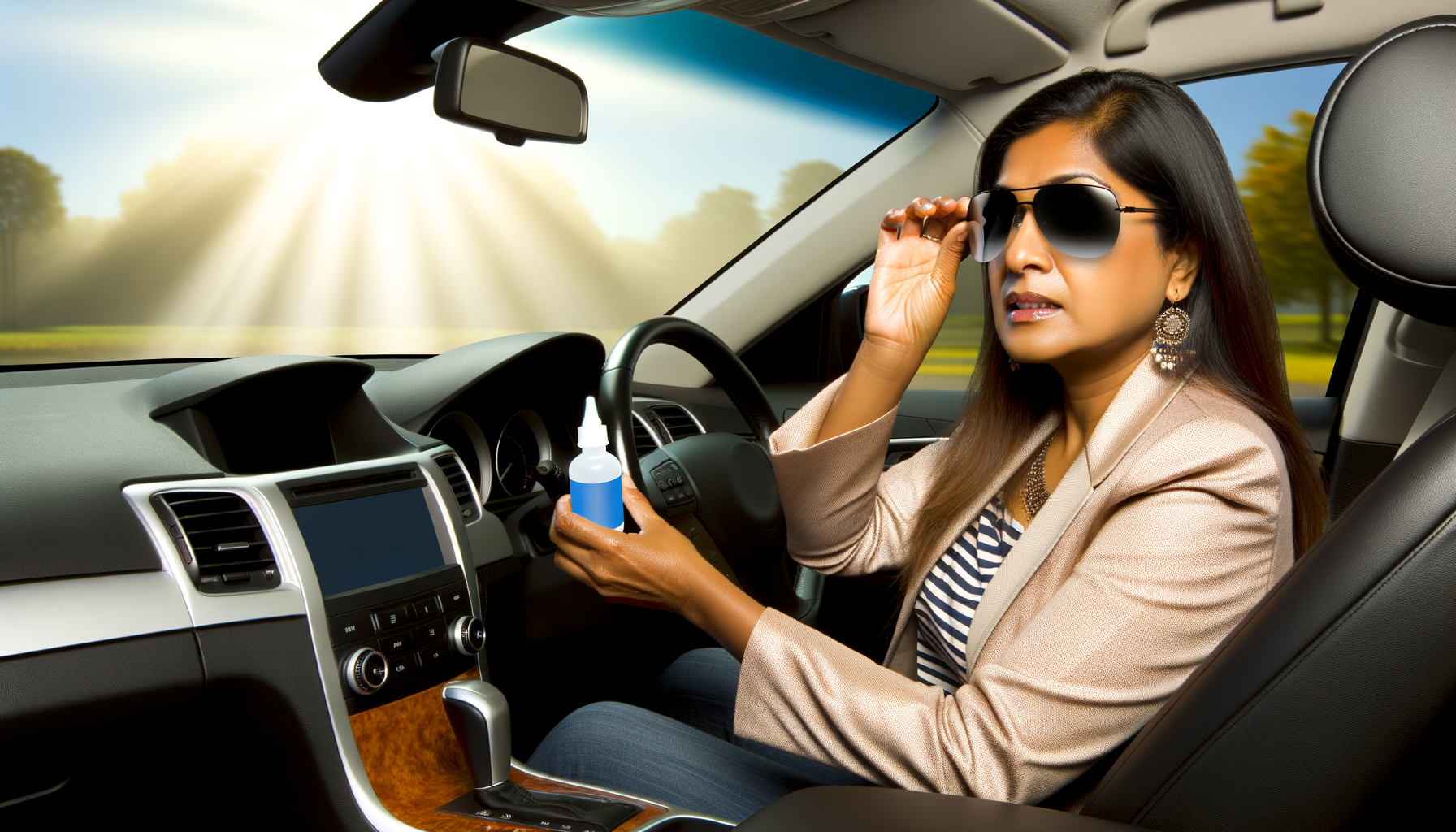Understanding the Link Between Dry Eyes and Driving
Driving requires keen visual acuity and attention, but for those suffering from dry eye disease (DED), this everyday activity can become a challenge. DED is a prevalent condition, affecting an estimated 5% to over 30% of the population, and is characterized by damage to the ocular surface, ocular discomfort, and impaired visual quality. These symptoms can be exacerbated by the environmental conditions inside a vehicle, such as air conditioning or heating, which reduce humidity and accelerate tear evaporation. The link between dry eyes and driving is thus a critical concern, as it directly impacts the driver’s ability to operate a vehicle safely and comfortably.
The Impact of Dry Eyes on Driving Performance
Dry eyes can significantly impair driving performance. Symptoms such as intermittent blurred vision, increased blink frequency, and ocular discomfort can distract drivers and reduce their ability to focus on the road. A study conducted at Peking University Third Hospital revealed that approximately 40% of drivers with DED had dangerous driving experiences, with a notable percentage of accidents and near-accidents attributed to visual disturbances caused by dry eyes. These findings underscore the importance of managing dry eye symptoms to ensure driving safety.
Overview of Dry Eye Symptoms and Causes
Dry eye symptoms include a stinging or burning sensation, grittiness, soreness, and blurred vision, which can fluctuate throughout the day based on environmental factors. The causes of DED are multifaceted, ranging from tear film abnormalities, such as reduced tear production or rapid tear evaporation, to external factors like low humidity and exposure to allergens. Lifestyle choices, such as prolonged screen time, and certain medications can also contribute to the development of dry eyes. Understanding these symptoms and causes is the first step toward effective management and maintaining optimal vision while driving.
Physiology of Dry Eyes
The Role of the Tear Film in Eye Health
The tear film is a complex, three-layered structure that coats the surface of the eye, playing a crucial role in maintaining ocular health and clear vision. The outermost lipid layer, produced by the meibomian glands, prevents tear evaporation. The middle aqueous layer, secreted by the lacrimal glands, provides moisture and nutrients, while the innermost mucin layer, produced by goblet cells, ensures even distribution of tears on the ocular surface. This tri-layered film protects the eye from environmental irritants, harbors antimicrobial properties, and is essential for a smooth refractive surface to support optimal vision.
Causes of Tear Film Dysfunction While Driving
While driving, several factors can contribute to tear film dysfunction. The controlled environment of a vehicle often lacks humidity, leading to increased tear evaporation. Air conditioning and heating systems can exacerbate this issue by directing airflow towards the face. Additionally, prolonged visual attention on the road decreases blink rate, which can disrupt the natural tear film replenishment cycle, leading to areas of dryness on the cornea.
How Dry Eyes Affect Vision and Driving Safety
Dry eyes can significantly impact driving safety. The tear film’s instability can cause fluctuating vision, making it difficult to focus clearly on the road, traffic signs, and potential hazards. The discomfort associated with dry eyes may also distract the driver, further increasing the risk of accidents. Moreover, the glare from oncoming headlights at night can be more pronounced in individuals with dry eyes, leading to decreased contrast sensitivity and impaired visual function. It is imperative for drivers to manage dry eye symptoms effectively to ensure their safety and the safety of others on the road.
Risk Factors for Developing Dry Eyes
Demographic and Lifestyle Risk Factors
Dry eye syndrome is a condition that can be influenced by a variety of demographic and lifestyle factors. Age is a significant factor, with individuals over the age of 50 being more prone to developing dry eyes. Gender also plays a role, as being assigned female at birth is associated with a higher risk of dry eye, potentially due to hormonal fluctuations. Lifestyle choices, such as wearing contact lenses, can exacerbate symptoms because they may affect the stability and production of the tear film. Additionally, environmental conditions like exposure to dry, dusty, or windy climates can lead to increased tear evaporation and dry eye symptoms. Prolonged activities that reduce blink frequency, such as driving, using a computer, or reading, can also contribute to the condition.
Impact of Diet and Medications
Dietary habits can influence eye health, with a diet low in vitamin A being linked to dry eye syndrome. Vitamin A is crucial for maintaining a healthy tear film and ocular surface. Medications are another contributing factor, with certain drugs such as antihistamines, blood pressure medications, and antidepressants having the potential to reduce tear production or increase tear evaporation, leading to dry eyes. It is important for individuals to be aware of the side effects of their medications and to discuss potential alternatives with their healthcare provider if dry eye symptoms persist.
Health Conditions and Previous Eye Surgeries
Various health conditions can predispose individuals to dry eyes. Diabetes, Sjögren syndrome, and lupus are among the systemic diseases that can affect tear production and quality. Additionally, previous eye surgeries, including LASIK, can disrupt the normal tear film and lead to dry eye symptoms. It is essential for individuals with these risk factors to monitor their eye health closely and seek professional advice for managing dry eye syndrome effectively.
Key Takeaways:
- Individuals over 50 and those assigned female at birth are at higher risk for dry eyes.
- Contact lens wear and environmental factors can contribute to dry eye symptoms.
- A diet lacking in vitamin A and certain medications can negatively impact tear film health.
- Systemic diseases and previous eye surgeries are significant risk factors for developing dry eyes.

Preventive Measures and Management Strategies
The Use of Artificial Tears and Eye Lubricants
One of the simplest and most effective ways to manage dry eyes while driving is the use of over-the-counter (OTC) artificial tears or eye lubricants. These products help maintain moisture on the ocular surface, providing temporary relief from the discomfort of dry eyes. It’s advisable to apply artificial tears before starting to drive, especially on longer trips. For those who experience more severe symptoms, gels and ointments may be beneficial, although they should ideally be used at night due to their tendency to cause temporary blurriness.
The Importance of Proper Eyewear
Proper eyewear is crucial when it comes to preventing dry eyes during driving. Wraparound sunglasses can protect your eyes from wind and sun exposure, which are common culprits for exacerbating dry eye symptoms. Polarized lenses are particularly effective in reducing glare from the sun, which can strain the eyes. For those who require vision correction, it’s important to ensure that glasses are clean and free of smudges to avoid additional eye strain. If contact lenses cause discomfort, switching to glasses during long drives is recommended.
Blinking Techniques and Ventilation Adjustments
Concentration while driving can lead to reduced blink rates, contributing to dry eye symptoms. To combat this, consciously remind yourself to blink more frequently, perhaps in rhythm with periodic milestones, such as during radio commercials or at certain intervals. Additionally, adjusting car ventilation is essential; ensure that air vents are directed away from the face to prevent tear evaporation and maintain a comfortable humidity level inside the vehicle.
Taking Breaks and Eye Resting Practices
Long periods of driving without breaks can intensify dry eye symptoms. It’s important to take regular breaks to rest your eyes. During these breaks, close your eyes for a few seconds to allow your tears to naturally lubricate your eyes. Upon reopening, perform several deliberate blinks to spread the tear film evenly across the eye surface. If symptoms persist, reapplying artificial tears can offer further relief. Remember, consistent eye care and attention to symptoms can prevent the progression of dry eye and ensure a safer, more comfortable driving experience.
In conclusion, managing dry eyes while driving involves a combination of proactive measures such as using artificial tears, wearing appropriate eyewear, adjusting blinking habits, and car ventilation, as well as taking regular breaks to rest the eyes. By incorporating these strategies into your driving routine, you can significantly reduce the discomfort of dry eyes and maintain clear vision on the road.

Popular Read
When to Seek Professional Help
Limitations of Over-the-Counter Remedies
While over-the-counter (OTC) remedies like artificial tears, gels, and ointments can provide temporary relief for dry eyes, they have their limitations. OTC artificial tears are designed for mild to moderate dry eye symptoms and may not be effective for everyone. Frequent use of drops with preservatives can lead to irritation, and gels and ointments can cause temporary blurriness, making them unsuitable for use while driving. If you find yourself using preservative-containing artificial tears more than four times a day or if your symptoms persist despite regular use of OTC products, it may be time to seek professional help.
Recognizing Symptoms That Require Medical Attention
It’s crucial to recognize when dry eye symptoms escalate to a level that requires medical attention. You should consult a healthcare professional if you experience:
- Persistent discomfort or pain in the eyes
- Severe redness or inflammation
- Consistent blurred vision or difficulty seeing at night
- Increased sensitivity to light
- Feeling of a foreign body in the eye that doesn’t go away
These symptoms could indicate a more serious condition or require prescription treatment to manage effectively. Additionally, if dry eyes are impacting your ability to drive safely, such as through delayed response times or difficulty focusing, professional evaluation is imperative.
Possible Treatments for Persistent Dry Eyes
For those with persistent dry eye symptoms, a variety of treatments are available beyond OTC remedies. After a thorough examination, an eye care professional may recommend:
- Prescription eye drops or inserts: These can help stimulate tear production or provide longer-lasting lubrication.
- Tear duct plugs: Also known as punctal plugs, these can prevent tears from draining too quickly from the eye’s surface.
- Anti-inflammatory medications: Topical steroids or other anti-inflammatories can reduce corneal inflammation and improve tear quality.
- Pulse light therapy: This treatment targets inflammation around the eye’s oil glands, improving the quality of tears.
- Lifestyle and dietary changes: Adjustments such as increasing omega-3 fatty acids in your diet or managing environmental factors can also help.
In more severe cases, surgical options may be considered to correct eyelid issues or to permanently close tear ducts. For contact lens wearers, switching to specialized lenses designed for dry eyes, such as scleral lenses, may provide relief.
Remember, dry eyes can be a symptom of underlying health conditions, so it’s important to address not just the symptoms but also the root causes. Regular comprehensive eye exams are essential for maintaining eye health and ensuring that any changes in vision or eye comfort are evaluated promptly.
Managing dry eyes is crucial for maintaining clear vision and ensuring safety while driving. When OTC remedies are not enough, or when symptoms suggest a more serious issue, seeking professional help is the next step. An eye care professional can provide a proper diagnosis and a tailored treatment plan to alleviate dry eye symptoms and protect your vision on the road.
By the way, something for you, a little gift!!!
I am just in the middle of publishing my book. It’s about How women can balance their hormones. One part is about food and diet, of course.
Follow this link and enter your email.
I will send you this part of the book for free once the book is published. It has many concrete, practical tips and recipes and will help you feel better during menopause or times of Big hormonal fluctuations.
Annette, Damiva Lead for Health & Wellness

Frequently Asked Questions
Common Causes of Dry Eyes During Driving
Many drivers experience dry eyes, which can be attributed to several factors. One common cause is insufficient blinking, often due to intense concentration on the road. Additionally, environmental factors such as direct airflow from car vents, air conditioning, or open windows can accelerate tear evaporation. Exposure to sunlight and glare, especially when driving in snowy conditions or during sunrise and sunset, can also contribute to dry eyes. For those who wear them, contact lenses may exacerbate the issue by affecting tear film stability.
Preventing Eye Fatigue on the Road
To prevent eye fatigue while driving, it’s essential to maintain good eye health and comfort. Here are some tips:
- Blink regularly: Consciously remind yourself to blink, especially during long periods of focused driving.
- Wear proper eyewear: Opt for glasses with polarized lenses to reduce glare and consider wearing glasses instead of contact lenses on long drives.
- Adjust car ventilation: Redirect air vents away from your face to prevent tear evaporation.
- Take breaks: Utilize rest stops to close your eyes briefly and allow your tears to naturally lubricate your eyes.
- Use artificial tears: Over-the-counter eye drops can help keep your eyes moist, especially before starting a long drive.
Identifying Serious Dry Eye Conditions
While occasional dry eyes may not be a cause for alarm, persistent or severe symptoms could indicate a more serious condition. It’s time to seek medical attention if you experience:
- Continuous discomfort: If dry eyes persist despite using over-the-counter remedies for a few weeks.
- Visual disturbances: Sudden blurriness, floaters, or vision loss could signal retinal detachment or other serious eye conditions.
- Signs of infection: Increased redness, pain, or discharge from the eyes.
Remember, while dry eyes can often be managed with simple measures, they can sometimes lead to complications like corneal abrasions or infections if left untreated. Therefore, it’s crucial to consult with an eye care professional if symptoms persist or worsen.
Remember: Your eyes are vital for safe driving. Taking proactive steps to manage dry eyes not only improves comfort but also ensures that your vision remains clear and focused on the road ahead.

Bette 100% All-Natural Relaxing Lavender Body Lotion.
Chemical-Free
Your relaxing night time body moisturizer to leave the day’s stress behind. Decompress and wish your body good night with the calming scent of lavender.
Conclusion
Summarizing the Importance of Managing Dry Eyes While Driving
Dry eyes can significantly impact daily activities, particularly driving, which requires optimal visual performance and comfort. The sensation of dry eyes while driving is not only uncomfortable but can also lead to visual disturbances that may compromise safety on the road. As we have explored throughout this article, dry eyes can result from various factors, including decreased tear production, increased tear evaporation, imbalanced tear composition, and reflex tearing. The symptoms, ranging from irritation and redness to blurred vision and sensitivity to light, underscore the necessity of managing this condition effectively.
Proper management of dry eyes is crucial for maintaining clear vision and preventing the potential risks associated with impaired driving performance. Utilizing artificial tears, ensuring proper eyelid hygiene, and employing blinking techniques are just a few strategies that can alleviate symptoms. Moreover, understanding the physiology of dry eyes and the role of the tear film in eye health allows individuals to take proactive steps in preventing the onset of symptoms, especially during extended periods behind the wheel.
Final Recommendations and Encouragement to Seek Help
For those experiencing persistent or severe symptoms of dry eyes while driving, it is imperative to seek professional help. Over-the-counter remedies may offer temporary relief, but they may not address the underlying causes of dry eye syndrome. Eye care professionals can provide a comprehensive evaluation and tailor treatments to individual needs, which may include prescription medications, specialized eye drops, or in-office procedures.
It is essential to recognize when symptoms go beyond the scope of self-management and require medical attention. Ignoring persistent dry eye symptoms can lead to more serious complications, affecting not only one’s quality of life but also the safety of all road users. Therefore, individuals are encouraged to consult with an ophthalmologist or optometrist if they experience frequent discomfort or visual impairment while driving.
In conclusion, managing dry eyes is of paramount importance for safe driving. By staying informed, taking preventative measures, and seeking professional care when necessary, drivers can ensure that their eyes remain healthy and their vision clear, allowing them to stay focused on the road ahead.








